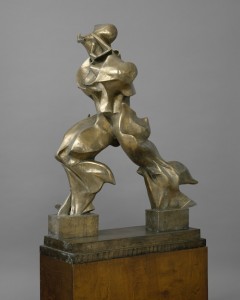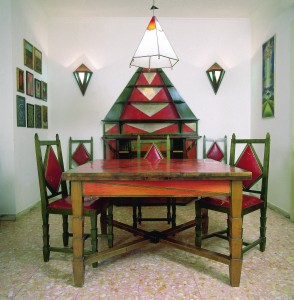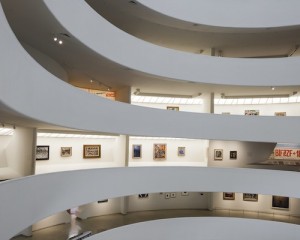This past week (summer 2014), I had the great good fortune to participate in a guided tour of the current exhibition at the Guggenheim Museum on Fifth Avenue in New York. The show is “Italian Futurism, 1909-1944: Reconstructing the Universe.”
I was part of a press group, and our narrator was Vivien Greene, the Guggenheim’s senior curator, 19th and early 20th century art. She organized the show, which opened Feb. 21 and closes Sept. 1 — which means there are still four weeks to get a good look at it.
I don’t normally write about art so I am undertaking this project with trepidation.
For starters, I had never heard of Italian Futurism, so our tour was like an introductory university course — although a lot more interesting than some I have attended!
Italian Futurism was about breaking with the past — and about pushing Italy quickly into the modern world.
The idea originated as a literary movement, but spread to the visual arts, and on to advertising, architectural design, fashion, film, home furnishings, music, poetry, photography and theater. Its adherents admired modern industry (even the smokestacks), machinery and the speed represented by urban life, modern communications and aviation.
They wanted to change the world fast and, to that end, extolled aggression and violence.
Just a note on that last point: This movement’s founding preceded World War I by only five years. Italy’s Futurists were angry that Italy did not immediately join that devastating fray (it did join the Allies in 1915). But, war is ancient. A truly modern idea would have been to advocate and strive for a world without war.
That did not happen. But Futurism, like all isms, bumped into reality. It is a great irony that Umberto Boccioni, a principal shaper of Futurism, was killed in World War I, not in battle but in a freak accident, something about a fall from a horse. His sculpture, “Unique Forms of Continuity in Space,” is seen in this photo and in the Guggenheim exhibit.

Umberto Boccioni
“Unique Forms of Continuity in Space (Forme uniche della continuità nello spazio),” 1913 (cast 1949)
Bronze, 121.3 x 88.9 x 40 cm
The Metropolitan Museum of Art, New York, Bequest of Lydia Winston Malbin, 1989
© The Metropolitan Museum of Art
Image Source: Art Resource, New York
The other reality was Benito Mussolini and the fascist state he headed between the world wars. Some Futurists left the country, others pursued their artistic and other endeavors outside the political arena and a third group — ardent nationalists — became propagandists. Political Futurism did not survive World War II.
As a result of this history, Guggenheim’s show is much more than an art exhibit. You don’t even have to understand or like modern art to appreciate it.
The exhibition, a multidisciplinary affair, relies on paintings and sculpture, of course, but also lets us see samples of architectural visions, ceramics, Futurist clothes, free-form poetry, photography — there is even a Futurist dining room set, seen in this photo. On loan for the show, it still belongs to the family that commissioned the work in the 1930s.

Gerardo Dottori
“Cimino Home Dining Room Set (Sala da pranzo di casa Cimino),” early 1930s
Table, chairs, buffet, lamp, and sideboard; wood, glass, crystal, copper with chrome plating, leather, dimensions variable
Private collection
© Gerardo Dottori
Photo: Daniele Paparelli, Courtesy Archivi Gerardo Dottori, Perugia, Italy
The museum also commissioned three documentary films to enhance its presentation and our understanding of Futurism’s many manifestations.
The exhibit is organized chronologically, starting with excerpts from the 1909 Futurist manifesto, in which the well-to-do writer and theorist Filippo Tommaso Marinetti laid out its founding principles.
The show starts at ground level and passes through the following decades as you ascend the museum’s ramps. Italian coffeemaker Lavazza is the lead sponsor of the show.

Inside New York’s Guggenheim Museum, view of the installation: “Italian Futurism, 1909–1944: Reconstructing the Universe.” Photo: Kris McKay © SRGF
For more about New York City, we offer at BestTripChoices.com the following, under the headline: No Rotten Apple here
https://besttripchoices.com/us-cities/new-york-city-new-york/
This blog and its photos are by Nadine Godwin, BestTripChoices.com editorial director and contributor to the trade newspaper, Travel Weekly. She also is the author of “Travia: The Ultimate Book of Travel Trivia,” which was published by The Intrepid Traveler.
